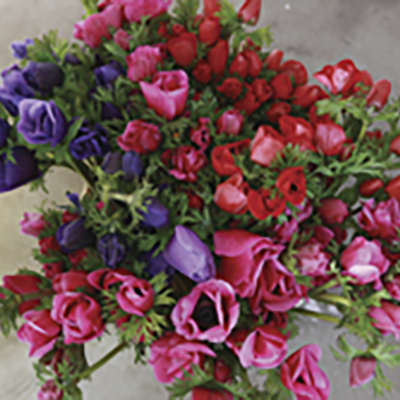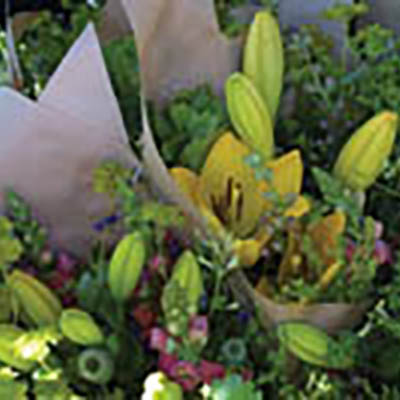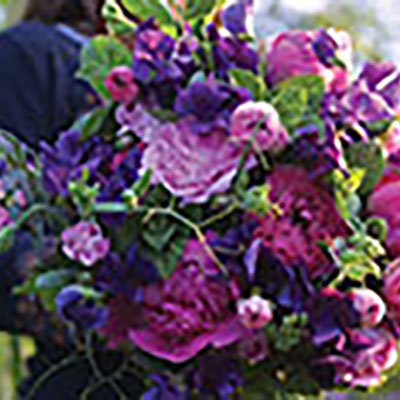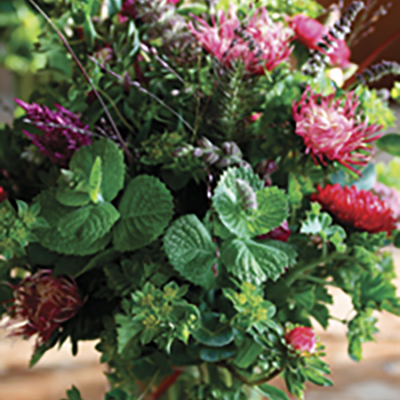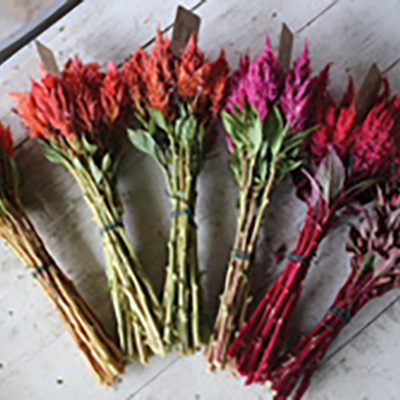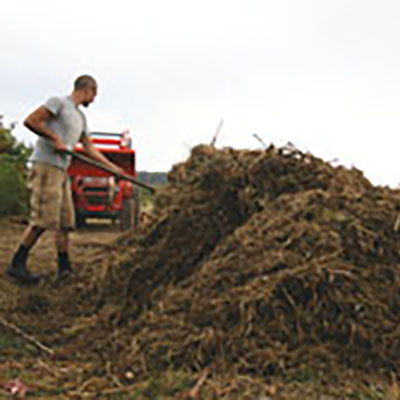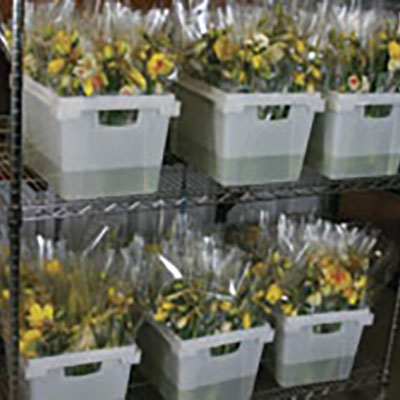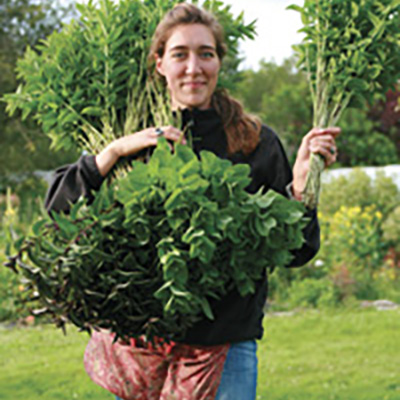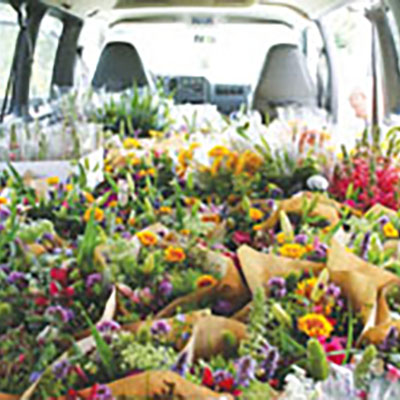This article originally appeared in the January 2011 issue of Growing For Market Magazine
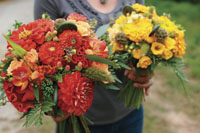
I absolutely adore dahlias! In my opinion, they are a nearly perfect crop to have on the farm. With an extremely long harvest window of up to 3 months, these brilliant gems have become the workhorse of our summer garden. There are thousands of varieties to choose from in nearly every shape, size and color and for a trialing fanatic like me the process of choosing is a blast! With just a few mother tubers one can easily and rapidly increase their stock, so a small investment will produce great rewards in no time. In addition to not shipping well, which gives local growers a major advantage, consumers also love and buy dahlias with great enthusiasm.
When I first began growing dahlias I planted only the Karma varieties. While they are extremely productive, bloom early in the season and have an exceptional vase life, I found that our buyers were not nearly as enthusiastic as I was about them. The Karmas bloom shape (water lily) and limited color range put them at the bottom of the ranks, at least here locally. We still grow roughly 500 Karmas each season but more as a bulk fill-in crop rather than one of our featured varieties. Over the past few years I have grown and trialed more than 125 different dahlias. While all have been beautiful in my eyes , I have definitely seen a theme among our customers as to which types they prefer. Semi cactus and balls are hands-down our biggest sellers. For weddings we generally get requests for white, purple, soft pink and coral blooms. Grocery stores consistently sell out of orange, hot pink, purple and deep red while yellow, primary red and light pink are the last to be scooped up. Designers are drawn to the more unusual types such as buttons, singles and dinnerplates but overall these novelties make up a small percentage of our overall sales.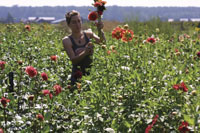
I first heard about the idea of taking cuttings to increase my dahlia stock from Bob Wollam in Virginia. He assured me that the process was simple and painless and, boy, was he right! Most varieties of dahlias can be propagated without fear of violating plant patents. The exception is the ‘Karma’ series, which is patented. Taking cuttings has enabled me to turn roughly 350 tubers into a patch of 1,400 thriving plants in just a few short months. If you have certain varieties that you’d like more of (one tuber can make 5-10 cuttings), want to have plants blooming earlier in the field (up to a month ahead) or are simply on a tight budget and can only afford a small tuber investment, there is no faster, easier method than taking cuttings to beef up your stock.
Starting in January and as late as March, we pull out the tubers we want to multiply. These are nestled in potting soil-filled bulb crates with their necks sticking above the soil line 1-2”. These crates are then tucked into a 70°F room with a shop light suspended about 6” above the tubers. This warm, bright environment prompts the dahlias to break dormancy and begin sending out fresh, green shoots in one to two weeks. Once these shoots have developed two or three sets of leaves, it’s time to take the first cuttings. I use a sharp hobby knife to slice the shoots about 1/16” above the crown of the tuber. Be sure not to go too deep into the tuber or you will completely remove the sprouting eye and any future production from that plant. Once the shoot is sliced off, it is then stuck into the rooting medium.
There are a few plug systems that make the rooting process simple, clean and successful. The first is the Oasis Wedge system which consists of trays filled with small plugs of Oasis floral foam. Cuttings stuck into the Oasis plugs root quickly — growers I have spoken to reported a 98% success rate and no rooting hormone was needed. The Oasis system is not allowed in organic production, however, so I can’t use it on our farm.
Recently, I stumbled onto something that is approved for organic production. Earth Pots, formerly called Ellepots, are 100% degradable small fabric sleeves that are vacuum filled with custom-blended propagation media.
OBC Northwest in Oregon (www.millermorse.com) offers a wide range of sizes and has the ability to fill them with an OMRI-certified potting mix. I am thrilled to have this option for our upcoming season! For non-organic growers, the use of rooting hormone will promote faster, more vigorous rooting but it is still possible to have great success by simply sticking cuttings directly into the moist Earth Pots.
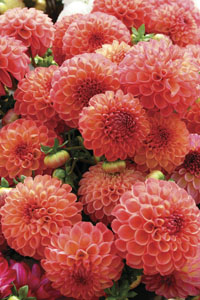
Once the cuttings have been stuck into the desired rooting medium, I place them in a solid-bottom tray filled with ¼” of water onto a 70°F heating mat and position the shop lights about 6” above the plants. If the cuttings are short enough, a clear plastic dome can be placed over the top to help retain moisture. I often let my cuttings get too large so instead have to leave them uncovered and mist three times a day. While time-consuming, it is essential to keep the leaves hydrated for proper rooting. In 5-12 days the cuttings should be rooted. I often give them another week on the heat mat to get really beefed up before replanting them into larger 4” pots.
We generally begin field planting about two weeks after our last frost date with the process normally consuming the first half of May. Prior to planting, all beds are given 2-4” of compost, rock phosphate, a little lime and a general organic fertilizer. Karmas are planted into landscape fabric with holes burned 18x18” with 3 rows per bed. They are then given one layer of Tenax support netting. The traditional tuber varieties are planted two rows per bed, spaced roughly a foot apart down the row. If we can scrounge up enough t-posts, which has becoming increasingly difficult, I love to run at least 2 lines of twine along the edges of each row to help keep plants from leaning too far into the aisles. Once the plants are in, we give them bi-weekly doses of compost tea to promote strong growth and help combat disease. In years past when we were tighter on space I crammed plants far too close together and was constantly battling disease. Since spreading the rows out to allow for better air circulation, we have seen an enormous decrease in disease, even during very wet weather. Once plants are about 18” tall we give them a hard pinch to 3-4 sets of leaves to promote branching, flower production and increased stem length.
Harvest and postharvest
For postharvest tips I asked Tony and Denise Gaetz from Bare Mountain Flowers in Oregon to share their secrets to long lasting dahlias. They said, “We harvest early in the day before noon and put all the stems in a solution using Chrysal’s Gerbera Chlorine tablets. We use 1 tablet per gallon water that has OVB hydrating solution. The flowers are left in the hydrating solution for 2 hours in our cooler and then transferred to a fresh container with one more chlorine tablet per gallon of fresh water. We use no flower food as we are typically moving the flowers to market within 24 hours of harvest. Once in the vase we do recommend use of a basic flower food.”
Bob Wollam in Virginia explained his system: ”We cut our dahlias into hot/warm water in the field and then again into hot water with a Chlorine pill and Chrysal #2 in the packing shed. We then try to hold them for 12 hours in the cooler at 38 degrees before taking to market.”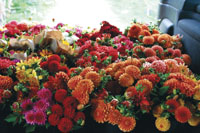
All of our dahlias are sold by the 5-stem bunch. For the first half of the season, before the market is flooded, we sell bunches wholesale for $3.50, dinnerplates for $5. This price holds steady until late August when other local growers begin to harvest in earnest and the price drops significantly. In years past I struggled to compete with these low prices but after watching 400+ bunches ordered from another farm wilt in 48 hour on the store’s shelf three weeks in a row, I have confidently held my prices and still sell out because we can guarantee a superior product.
In the fall after a few hard frosts, typically early November, we start the exhausting process of digging and storing tubers. I know some growers are able to employ the help of machinery for this process but around here, the whole thing is done by hand, one clump at a time. Pheew!
Over the years I have tried numerous methods for storing tubers once they are dug and divided. The most successful has been the “Saran wrap” method.
After the tuber clumps are lifted and washed, they’re given a 5% bleach solution dip and then laid out to dry in our cool garage for a day or two. Once the clumps are dry they are carefully divided. I begin by splitting the clump in half using sharp pruners which gives me two pieces. The halved clumps are then divided again into individual tubers. In order to have a viable tuber it is essential that the eye and neck are left unharmed. If you don’t know what an eye looks like, visit this page for a quick tutorial: www.scdahlias.org/howto/index.cgi?howto=digdivide once all of the tubers are separated I simply wrap each in a piece of plastic wrap, tuck them into cardboard boxes and store them in a cool room in our basement for the winter. In past years this method achieved a 95% survival rate and the few tubers that did rot were safely kept away from the others by the plastic barrier.
Tony and Denise from Bare Mountain also shared their storage method. “We pack our tubers in pine wood shavings and store them in our flower cooler (during the off season at 40°F. This cooler keeps the tubers from breaking dormancy until planting time. The key to good storage is choosing healthy tubers with no damage or signs of rot and packing them well in wood chips only after they are dry.”
Sources
Swan Island Dahlias in Canby, Oregon, offers wholesale pricing for growers who spend over $250 on their initial order; reoccurring orders within the same season only require a $100 min to qualify. Varieties must be purchased in lots of 10. www.dahlias.com
Accent Dahlias here in WA is one of my most treasured sources for hard to find varieties as well as tried and true favorites. Owner Ken Greenway is a wealth of information who generously shares his knowledge! I have ordered from Accent for years and am always thoroughly pleased with their tubers and service. Currently they do not offer wholesale pricing. http://dahliasuppliers.com/accent/index.htm
With so many wonderful qualities, it’s hard to not be completely in love with Dahlias!
Erin Benzakein runs Floret, a small organic flower farm in Washington State; www.floretflowers.com
Erin Benzakein lists these as her favorite and bestselling dahlias:
• Café Au Lait: a fantastically romantic soft pink/cream dinner plate. A favorite with high end designers and our retail clients!
• Jomanda: beautiful coral/orange ball. Very productive, nice long stems, great color.
• Robin Hood: incredible peachy colored ball. Great stems for cutting, very productive and a favorite with buyers.
• Cornel: My all-time favorite red. Deep rich color, extremely productive, sells out.
• Fatma: darling vibrant hot pink button with wonderfully long stems. Blooms its head off all season and sells out every week.
• Marteen de Szwann (Karma): it’s hard to find a good white but this variety fills the bill. Tall, strong stems, clean crisp color and very productive.
• Kenora Wow: an incredible fuchsia/magenta with a hint of yellow. Nice tall stems, good vase life, sells out. Needs staking!
• Sangria (Karma): My favorite of the Karmas. The ultimate workhorse in our Dahlia patch with huge, tall stems, a great peachy color and it sells well.
• Intrigue: a fantastic, unusual peach/coral/orange color. Very productive and sells extremely well.
• Nijinski: a nice purple ball with long stems and good production.

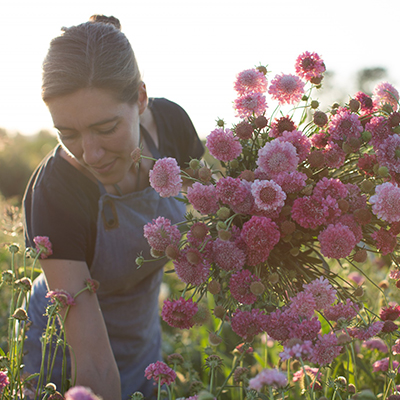
 Marketing is the other half of the battle
Marketing is the other half of the battle